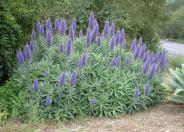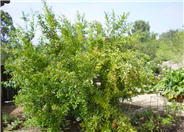
Common name:CatMint
Botanical name:Nepeta X Faassenii
Nepeta faassenii makes soft, gray-green, undulating mounds o 1.5 ft. high in bloom. The small leaves are attractive to cats. This perennial has lavender blue flowers in late spring, and early summer.

Common name:Pride Of Madeira
Botanical name:Echium candicans
Mature specimens of this evergreen shrub can grow to a size of 6'-8' tall and 8'-10' wide. In the spring, spikes of blue-purple flowers appear above the gray green foliage. It should receive full sun in coastal areas. In warmer inland areas, it should get some afternoon shade and more water during summer. However, once it's established, it needs little or no summer watering. This plant can be severely damaged by frost below 25 degrees F. Prune during fall to encourage lower branches to bloom. Great shrub for hillsides where it can spread. Honey bees love this plant. Does great in poor, dry soil. All parts of plant are poisonous. It appears to spread slowly into established native plant communities. Consider not planting echium if you live next to native plants.

Common name:Mexican Bush Sage
Botanical name:Salvia leucantha
The Mexican sage is a bushy shrub that grows 3-4 ft. tall and wide. It has hairy white stems, gray-green leaves and velvet like purple flower spikes that bloom summer through fall. This shrub tolerates sun, light shade, little water, and is hardy to 15 d

Common name:Coast Live Oak
Botanical name:Quercus agrifolia
The coast live oak is and evergreen round-headed tree. It can reach 15-40 ft. high and 20 ft. wide and grows very well from the coastal areas to the interior valleys. It is native to California, is drought tolerant, and attracts butterflies. -Cornflower

Common name:Wonderful Pomegranate
Botanical name:Punica granatum 'Wonderful'
This relatively small tree will grow 20' high x 15' wide and produces red flowers that bloom in the spring. The red/orange fruit appears in September and ripens in October and November.
Designer: Michelle Dervis
Photographer: Michelle Dervis
Practice grass-cycling by leaving short grass clippings on lawns after mowing, so that nutrients and organic matter are returned to the soil.
Mulching around plants helps retain water and improves the soil.
Attract, or buy beneficial insects such as ladybugs and lacewings to control pest outbreaks in your garden.